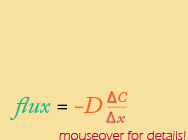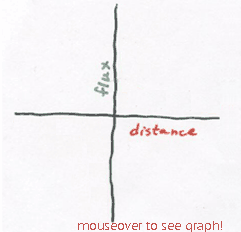How does flux depend on distance?
Now let's think about Fick's First Law in a different way. Before, we were interested in the steepness of the gradient as the independent variable (what happens to flux when the gradient gets steeper?). Now we're going to switch gears and think about how flux changes as the distance changes. In other words, we will choose to work with distance as the independent variable (isn't this fun? we can make the independent variable anything we want!). To do this, we'll need to use the discrete version of Fick's First Law:

This time, Δx is the independent variable, and we assume that all the other quantities that appear on the right hand side of the equation are not going to change while we are interpreting the equation. The relationship is now an example of "inverse variation", otherwise known as what happens when you divide by the independent variable, or try to graph something like y = a/x.
 |
 |
If the distance Δx is very small, then the flux is huge. As the distance increases, flux falls off quickly. With a big value of Δx, flux is almost 0 (although it never quite reaches zero).
So, what does this mean biologically?
E. coli cells average about 2 µm in length, while S. cerevisiae (baker's yeast) cells measure about 9 µm. Assuming the same gradient and D occurs in each cell, how do you compare the flux?
(To make this problem interactive, turn on javascript!... may not work in Internet Explorer )
- I need a hint ... : Flux in the E. coli would be:
-D * ΔC/2
- ...another hint ... : Flux in the S. cerevisiae would be:
-D * ΔC/9
- ...another hint ... : What is the ratio of two fluxes?
I think I have the answer: -D * (ΔC/2) / (-D *
ΔC/9) =
9/2, so flux in E. coli is 4.5 times greater than in S. cerevisiae
Copyright University of Maryland, 2007
You may link to this site for educational purposes.
Please do not copy without permission
requests/questions/feedback email: mathbench@umd.edu